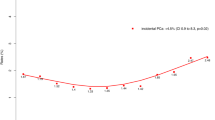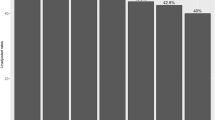Abstract
Background
There is concern that African-American men (AA) with low-risk prostate cancer may present with more aggressive disease and thus may not be candidates for active surveillance (AS). However, it is uncertain if poorer outcomes are due to disparities in access to medical care rather than true biological differences.
Methods
Observational cohort study of patients diagnosed with low-risk PC—Gleason score ≤6, clinical tumor stage ≤2A, and prostate specific antigen (PSA) level ≤10—at US Department of Veterans Affairs between January 1, 2001 and October 31, 2015 and treated with radical prostatectomy. Outcomes included upgrading to Gleason Grade Group 2 (GG2), GG ≥ 3, PSA recurrence, pathologic tumor stage ≥3, positive surgical margins, and all-cause mortality.
Results
A total of 2857 men (AA: 835 White: 2022) with a median follow-up of 7.1 years. Overall, there was no significant difference between AA and White men in upgrading to GG ≥ 3 (RR = 1.18, p = 0.43), tumor stage ≥3 (RR = 0.95, p = 0.74), positive surgical margins (RR = 1.14, p = 0.20), PSA recurrence (SHR = 1.26, p = 0.06), and all-cause mortality (SHR = 1.26, p = 0.16). However, there was a significant increase in upgrading for AA to GG2 (RR = 1.49, p < 0.01).
Conclusions
There was no significant difference in most adverse pathologic outcomes between AA and White patients. However, GG2 upgrading was more common in AA men. The implication is that AA may need to undergo additional evaluation, such as a biopsy MRI, before initiating AS. Whether the increase in GG2 upgrading will lead to poorer long-term clinical outcomes such as metastasis and PCSM also requires further investigation.
This is a preview of subscription content, access via your institution
Access options
Subscribe to this journal
Receive 4 print issues and online access
$259.00 per year
only $64.75 per issue
Buy this article
- Purchase on Springer Link
- Instant access to full article PDF
Prices may be subject to local taxes which are calculated during checkout


Similar content being viewed by others
References
Sundi D, Ross AE, Humphreys EB, Han M, Partin AW, Carter HB, et al. African American men with very low-risk prostate cancer exhibit adverse oncologic outcomes after radical prostatectomy: should active surveillance still be an option for them? J Clin Oncol. 2013;31:2991–7.
Sundi D, Schaeffer EM. Active surveillance for African-American men with prostate cancer: proceed with caution. Con Oncol. 2014;28:85.
Moul JW. Active surveillance for African-American men with prostate cancer: of course! Pro. Oncology. 2014;28:84–5.
Mahal BA, Alshalalfa M, Spratt DE, Davicioni E, Zhao SG, Feng FY, et al. Prostate cancer genomic-risk differences between African-American and White Men across Gleason Scores. Eur Urol. 2019;75:1038–40.
Mahal BA, Berman RA, Taplin ME, Huang FW. Prostate cancer-specific mortality across Gleason scores in black vs. non-black men. JAMA 2018;320:2479–81.
Odom BD, Mir MC, Hughes S, et al. Active surveillance for low-risk prostate cancer in African American men: a multi-institutional experience. Urology 2014;83:364–8.
Iremashvili V, Soloway MS, Rosenberg DL, Manoharan M. Clinical and demographic characteristics associated with prostate cancer progression in patients on active surveillance. J Urol. 2012;187:1594–9.
Abern MR, Bassett MR, Tsivian M, Banez LL, Polascik TJ, Ferrandino MN, et al. Race is associated with discontinuation of active surveillance of low-risk prostate cancer: results from the Duke Prostate Center. Prostate Cancer Prostatic Dis. 2013;16:85–90.
Sundi D, Faisal FA, Trock BJ, Landis PK, Feng Z, Ross AE, et al. Reclassification rates are higher among African American men than Caucasians on active surveillance. Urology. 2015;85:155–60.
Davis JW, Ward JF 3rd, Pettaway CA, Wang X, Kuban D, Frank SJ, et al. Disease reclassification risk with stringent criteria and frequent monitoring in men with favourable-risk prostate cancer undergoing active surveillance. BJU Int. 2015;118:68–76.
Tosoian JJ, Mamawala M, Epstein JI, Landis P, Macura KJ, Simopoulos, et al. Active surveillance of grade group 1 prostate cancer: long-term outcomes from a large prospective cohort. Eur Urol. 2020;S0302-2838(19)30961-3.
Maurice MJ, Sundi D, Schaeffer EM, Abouassaly R. Risk of pathological upgrading and up staging among men with low risk prostate cancer varies by race: results from the National Cancer Database. J Urol 2017;197:627–31.
Katz JE, Chinea FM, Patel VN, Balise RR, Venkatramani V, Gonzalgo ML. Disparities in Hispanic/Latino and non-Hispanic Black men with low-risk prostate cancer and eligible for active surveillance: a population-based study. Prostate Cancer Prostatic Dis. 2018;21:533–8.
Tan DS, Mok TS, Rebbeck TR. Cancer genomics: diversity and disparity across ethnicity and geography. J Clin Oncol. 2016;34:91–101.
Krimphove MJ, Cole AP, Fletcher SA, Harmouch SS, Berg S, Lipsitz SR, et al. Evaluation of the contribution of demographics, access to health care, treatment, and tumor characteristics to racial differences in survival of advanced prostate cancer. Prostate Cancer Prostatic Dis. 2019;22:125–36.
Carlsson SV, Albertsen PC. Better survival after curative treatment for screen-detected prostate cancer compared with clinical diagnosis: a real effect or lead-time bias? Eur Urol. 2015;68:183–4.
Kaur D, Ulloa-Perez E, Gulati R, Etzioni R. Racial disparities in prostate cancer Survival in a screened population: reality versus artifact. Cancer. 2018;124:1752–9.
Department of Veterans Affairs. About VHA. Washington, DC:Department of Veterans Affairs; 2016. https://www.va.gov/health/aboutvha.asp.
National Comprehensive Cancer Network. NCCN Guidelines for patients: prostate cancer. Plymouth Meeting, PA: National Comprehensive Cancer Network; 2019. https://www.nccn.org/patients/guidelines/prostate/files/assets/common/downloads/files/prostate.pdf.
Charlson M, Szatrowski TP, Peterson J, Gold J. Validation of a combined comorbidity index. J Clin Epidemiol. 1994;47:1245–51.
Coogan PF, Castro-Webb N, Yu J, O’Connor GT, Palmer JR, Rosenberg L. Neighborhood and individual socioeconomic status and asthma incidence in African American women. Ethnicity Dis. 2016;26:113–22.
Faries D, Leon AC, Haro JM, Obenchain RL. Analysis of observational health care data using SAS. Cary, NC: SAS Institute Inc; 2010.
Carter HB, Kettermann A, Warlick C, Metter EJ, Landis P, Walsh PC, et al. Expectant management of prostate cancer with curative intent: an update of the Johns Hopkins experience. J Urol 2007;178:2359–64.
Tosoian JJ, Trock BJ, Landis P, Feng Z, Epstein JI, Partin AW, et al. Active surveillance program for prostate cancer: an update of the Johns Hopkins experience. J Clin Oncol. 2011;29:2185–90.
Klotz L, Zhang L, Lam A, Nam R, Mamedov A, Loblaw A. Clinical results of long-term follow-up of a large, active surveillance cohort with localized prostate cancer. J Clin Oncol. 2010;28:126–31.
Dall’Era MA, Konety BR, Cowan JE, Shinohara K, Stauf F, Cooperberg MR, et al. Active surveillance for the management of prostate cancer in a contemporary cohort. Cancer. 2008;112:2664–70.
van den Bergh RC, Vasarainen H, van der Poel HG, Vis-Maters JJ, Rietbergen JB, Pickles T, et al. Short-term outcomes of the prospective multicentre ‘Prostate Cancer Research International: Active Surveillance’ study. BJU Int. 2010;105:956–62.
van As NJ, Norman AR, Thomas K, Khoo VS, Thompson A, Huddart R, et al. Predicting the probability of deferred radical treatment for localised prostate cancer managed by active surveillance. Eur Urol. 2008;54:1297–305.
Berglund RK, Masterson TA, Vora KC, Eggener SE, Eastham JA, Guillonneau BD. Pathological upgrading and up staging with immediate repeat biopsy in patients eligible for active surveillance. J Urol. 2008;180:1964–7.
Soloway MS, Soloway CT, Williams S, Ayyathurai R, Kava B, Manoharan M. Active surveillance; a reasonable management alternative for patients with prostate cancer: the Miami experience. BJU Int. 2008;101:165–9.
Soloway MS, Soloway CT, Williams S, Ayyathurai R, Kava B, Manoharan M. Careful selection and close monitoring of low-risk prostate cancer patients on active surveillance minimizes the need for treatment. Eur Urol. 2010;58:831–5.
Makridakis NM, Ross RK, Pike MC, Crocitto LE, Kolonel LN, Pearce CL, et al. Association of mis-sense substitution in SRD5A2 gene with prostate cancer in African-American and Hispanic men in Los Angeles, USA. Lancet. 1999;354:975–8.
Yamoah K, Johnson MH, Choeurng V, Faisal FA, Yousefi K, Haddad Z, et al. Novel biomarker signature that may predict aggressive disease in African American men with prostate cancer. J Clin Oncol. 2015;33:2789–96.
Jalloh M, Myers F, Cowan JE, Carroll PR, Cooperberg MR. Racial variation in prostate cancer upgrading and upstaging among men with low-risk clinical characteristics. Eur Urol. 2015;67:451–7.
Schreiber D, Chhabra A, Rineer J, Weedon J, Schwartz D. A population-based study of men with low-volume low-risk prostate cancer: does African-American race predict for more aggressive disease? Clin Genitourin Cancer. 2015;13:e259–64.
Dinh KT, Mahal BA, Ziehr DR, Muralidhar V, Chen YW, Viswanathan VB. Incidence and predictors of upgrading and up staging among 10,000 contemporary patients with low risk. Prostate Cancer. 2015;194:343–9.
Optenberg SA, Thompson IM, Friedrichs P, Wojcik B, Stein CR, Kramer B. Race, treatment, and long-term survival from prostate cancer in an equal-access medical care system. JAMA. 1995;274:1599–605.
Leapman MS, Freedland SJ, Aronson WJ, Kane CJ, Terris MK, Walker K, et al. Pathological and biochemical outcomes among African-American and Caucasian men with low risk prostate cancer in the SEARCH database: implications for active surveillance candidacy. J Urol. 2017;196:1408–14.
Dess RT, Hartman HE, Mahal BA, Soni PD, Jackson WC, Cooperberg MR, et al. Association of black race with prostate cancer-specific and other-cause mortality. JAMA Oncol. 2019;5:975–83.
Wilt TJ, Jones KM, Barry MJ, Andriole GL, Culkin D, Wheeler T. Follow-up of prostatectomy versus observation for early prostate Cancer. N Engl J Med. 2017;377:132–42.
Schenk JM, Newcomb LF, Zheng Y, Faino AV, Zhu K, Nyame YA, et al. African American race is not associated with risk of reclassification during active surveillance: results from the Canary Prostate Cancer Active Surveillance Study (PASS). J Urol. 2020;203:727–33.
Riviere P, Luterstein E, Kumar A, Vitzthum L, Sarkar RR, Bryant AK, et al. Racial equity among African-American and Non-Hispanic white men diagnosed with prostate cancer in the Veterans Affairs Healthcare System. Int J Radiat Oncol Biol Phys. 2019;105:E305.
Murtola TJ, Syvala H, Tolonen T, Helminen M, Riikonen J, Koskimaki J, et al. Atorvastatin versus placebo for prostate cancer before radical prostatectomy—a randomized double-blind, placebo-controlled clinical trial. Eur Urol 2018;74:697–701.
Foerster B, Pozo C, Abufaraj M, Mari A, Kimura S, D’Andrea D, et al. Association of smoking status with recurrence, metastasis, and mortality among patients with localized prostate cancer undergoing prostatectomy or radiotherapy: a systematic review and meta-analysis. JAMA Oncol. 2018;4:953–61.
Department of Veterans Affairs. Medication Copayments. Washington, DC: Department of Veterans Affairs; 2017. https://www.va.gov/healthbenefits/resources/publications/IB10-971_medication_copayment_brochure.pdf.
Author information
Authors and Affiliations
Corresponding author
Ethics declarations
Conflict of interest
The authors declare that they have no conflict of interest.
Additional information
Publisher’s note Springer Nature remains neutral with regard to jurisdictional claims in published maps and institutional affiliations.
Supplementary information
Rights and permissions
About this article
Cite this article
Deka, R., Parsons, J.K., Simpson, D.R. et al. African-American men with low-risk prostate cancer treated with radical prostatectomy in an equal-access health care system: implications for active surveillance. Prostate Cancer Prostatic Dis 23, 581–588 (2020). https://doi.org/10.1038/s41391-020-0230-6
Received:
Revised:
Accepted:
Published:
Issue Date:
DOI: https://doi.org/10.1038/s41391-020-0230-6
This article is cited by
-
The association of patient and disease characteristics with the overtreatment of low-risk prostate cancer from 2010 to 2016
Prostate Cancer and Prostatic Diseases (2024)
-
Substantial Gleason reclassification in Black men with national comprehensive cancer network low-risk prostate cancer – A propensity score analysis
Prostate Cancer and Prostatic Diseases (2022)
-
Trends and practices for managing low-risk prostate cancer: a SEER-Medicare study
Prostate Cancer and Prostatic Diseases (2022)



